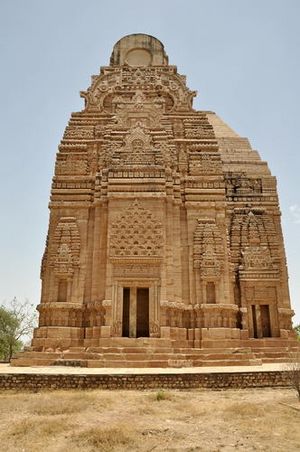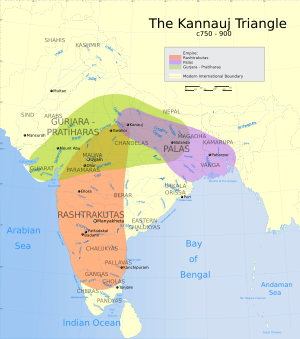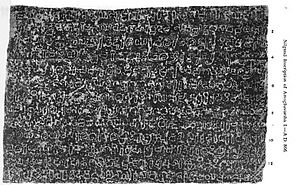Gurjara-Pratihara dynasty facts for kids
Quick facts for kids
Gurjara Pratihara dynasty
|
|||||||||||||||||||||||||||
|---|---|---|---|---|---|---|---|---|---|---|---|---|---|---|---|---|---|---|---|---|---|---|---|---|---|---|---|
| c. 730 CE–1036 CE | |||||||||||||||||||||||||||
|
Gurjara-Pratihara coinage of Mihira Bhoja, King of Kanauj. Obv: Boar, incarnation of Vishnu, and solar symbol. Rev: Traces of Sasanian type. Legend: Srímad Ādi Varāha "The fortunate primaeval boar".
|
|||||||||||||||||||||||||||
| Capital |
|
||||||||||||||||||||||||||
| Common languages | Sanskrit, Prakrit | ||||||||||||||||||||||||||
| Religion | Hinduism | ||||||||||||||||||||||||||
| Government | Monarchy | ||||||||||||||||||||||||||
|
• c. 730 – c. 760
|
Nagabhata I (first) | ||||||||||||||||||||||||||
|
• c. 1024 – c. 1036
|
Yasahpala (last) | ||||||||||||||||||||||||||
| Historical era | Late Classical India | ||||||||||||||||||||||||||
|
• Established
|
c. 730 CE | ||||||||||||||||||||||||||
| 1008 CE | |||||||||||||||||||||||||||
|
• Disestablished
|
1036 CE | ||||||||||||||||||||||||||
|
|||||||||||||||||||||||||||
| Today part of | India Bangladesh |
||||||||||||||||||||||||||
The Gurjara-Pratihara dynasty was a powerful kingdom in Northern India. They ruled from the mid-8th century to the 11th century. Their first capital was Ujjain, and later they moved to Kannauj.
The Gurjara-Pratiharas were very important in stopping Arab armies. These armies were trying to move east from the Indus River. Nagabhata I famously defeated an Arab army around 738 CE. Under Nagabhata II, the Gurjara-Pratiharas became the strongest kingdom in northern India.
The dynasty reached its greatest power under Mihira Bhoja and his son Mahendrapala I. Their empire became as large as the Gupta Empire. It stretched from Sindh in the west to Bengal in the east. It also reached from the Himalayas in the north to areas south of the Narmada river. This expansion led to a big struggle with the Rashtrakuta and Pala empires. They all fought for control of the Indian subcontinent. During this time, the Pratihara rulers called themselves Maharajadhiraja of Āryāvarta, meaning "Great King of Kings of Aryan Lands."
The Gurjara-Pratihara dynasty is known for its beautiful sculptures and temples. Many of their temples were built in an open pavilion style. The most famous example of their temple building style is at Khajuraho. This site is now a UNESCO World Heritage Site.
The power of the Gurjara-Pratihara dynasty slowly weakened. This happened because of fights within the royal family. A major raid by the Rashtrakuta ruler Indra III also hurt them. He attacked and looted Kannauj around 916 CE. After this, the dynasty never fully recovered its strength. Their local rulers became more powerful and broke away. By the late 10th century, the empire was much smaller. Their last important king, Rajyapala, was forced to leave Kannauj by Mahmud of Ghazni in 1018.
Contents
Who Were the Gurjara-Pratiharas?
The name "Gurjara" in the dynasty's title has been a topic of discussion among historians. The rulers themselves called their family "Pratihara." They believed they were descendants of the hero Lakshmana. He was said to be a pratihara (meaning "door-keeper") for his brother Rama.
Other kingdoms often called the Pratiharas "Gurjara." The full name "Gurjara-Pratihara" is found in only one old writing. Some historians think "Gurjara" was the name of the area they first ruled. Over time, it might have referred to the people from that region.
Another idea is that "Gurjara" was the name of a tribe, and Pratihara was a part of that tribe. There was also a theory that they came from outside India. This idea is not widely accepted by historians today. There is no strong proof that they were foreigners. They were well-integrated into Indian culture.
History of the Pratihara Empire
Historians debate where the Pratiharas first became powerful. Some believe their original capital was Ujjain. Others think it was in the Bhinmala Jalor area. This is because an old story was written in Jalor during the time of their early ruler Vatsaraja.
Early Rulers and Expansion
Nagabhata I (ruled 730–760 CE) was an early important ruler. He became strong after resisting Arab invaders from Sindh. Nagabhata I expanded his control to Malwa and Gujarat. He set up his capital in Avanti. He stopped the Arabs from expanding further into India. An old writing says Nagabhata was like the god Vishnu. He appeared to protect people and defeat the powerful "Mleccha" (foreign) ruler.
After Nagabhata I, his nephews Devraj and Kakkuka ruled for a short time. Then, Vatsraja (ruled 775–805 CE) took over.
Fighting Against Arab Armies
The Gurjara-Pratiharas were known for their strong army. An old record says Nagabhata "crushed the large army of the powerful Mlechcha king." This army included cavalry (horse soldiers), foot soldiers, and war camels.
An Arab writer named Sulaiman described the Pratihara army in 851 CE. He said, "The ruler of Gurjara has many forces. No other Indian prince has such fine cavalry." He also noted that the Pratihara ruler was not friendly to the Arabs. He had great wealth and many camels and horses.
Taking Control of Kannauj
After controlling much of Rajasthan, Vatsaraja wanted to rule all the land between the two seas. He fought against the Palas of Bengal, led by Dharmapala. Vatsaraja defeated Dharmapala, who had to flee.
Vatsaraja expanded his kingdom across northern India. It stretched from the Thar Desert in the west to the borders of Bengal in the east.
The city of Kannauj was very important. After the death of King Harsha, there was no strong ruler there. This led to a "tripartite struggle" (a three-way fight) for control of Kannauj. The Pratiharas, the Palas from the east, and the Rashtrakutas from the south all wanted the city.
Vatsaraja defeated both the Pala ruler Dharmapala and the Rashtrakuta king Dantidurga. This gave him control of Kannauj.
Around 786 CE, the Rashtrakuta ruler Dhruva attacked. He defeated Vatsraja around 800 CE. Vatsaraja was followed by Nagabhata II (ruled 805–833 CE). Nagabhata II was first defeated by the Rashtrakuta ruler Govinda III. But he later regained control of Malwa. He also conquered Kannauj and parts of the Indo-Gangetic Plain from the Palas. He also stopped the Muslims in the west again. Nagabhata II rebuilt the great Shiva temple at Somnath in Gujarat. This temple had been destroyed in an Arab raid. Kannauj became the main city of the Gurjara-Pratihara kingdom. At its peak (around 836–910 CE), it covered much of northern India.
The Reign of Mihira Bhoja

Mihira Bhoja (ruled 836–885 CE) was a very important king. He first made his own territories strong by stopping local rebellions. Then, he turned his attention to his old enemies, the Palas and Rashtrakutas.
When Mihira Bhoja became king, the Pratihara family's power was low. This was due to defeats suffered by his father, Ramabhadra. Bhoja attacked the Pala Empire of Bengal. He was defeated by King Devapala.
He then launched campaigns to conquer areas south of his empire. He was successful in taking Malwa, Deccan, and Gujarat. By the end of his rule, Bhoja had destroyed the Gujarat Rashtrakuta dynasty.
Bhoja was not only a conqueror but also a smart leader. He slowly rebuilt the empire. He conquered lands in Rajputana, Gujarat, and Madhya Pradesh. His kingdom reached to the east of the Sutlej river.
An old text called Rajatarangini says Bhoja's lands reached Kashmir in the north. He also conquered Punjab. After Devapala's death, Bhoja defeated the Pala King Narayanapala. He expanded his borders eastward into Pala lands near Gorakhpur.
A 10th-century Persian text describes the powerful "Rai of Qinnauj" (Kannauj). It says most Indian kings recognized his power. His army had 150,000 cavalry and 800 war elephants.
His son Mahenderpal I (ruled 890–910 CE) expanded the empire even further east. He reached Magadha, Bengal, and Assam.
Decline of the Empire
The empire started to decline after Bhoja II (ruled 910–912 CE) was overthrown by Mahipala I (ruled 912–944 CE). Many local rulers who were part of the empire declared their independence. These included the Paramaras, Chandelas, Kalachuris, Tomaras, and Chahamanas.
The south Indian Emperor Indra III of the Rashtrakuta dynasty briefly captured Kannauj in 916 CE. Even though the Pratiharas got the city back, their power kept weakening. This was partly because they had to fight attacks from the west (Turkic groups), the south (Rashtrakutas), and the east (Palas).
By the end of the 10th century, the Gurjara-Pratihara lands had shrunk. They controlled only a small area around Kannauj. Mahmud of Ghazni captured Kannauj in 1018 CE. The Pratihara ruler Rajapala fled. He was later caught and killed by the Chandela ruler Vidyadhara. The Chandela ruler then put Rajapala's son, Trilochanpala, on the throne. Yasahpala, the last Gurjara-Pratihara ruler of Kannauj, died in 1036 CE.
The Imperial Pratihara dynasty broke into many smaller states. These smaller states often fought each other. One branch of the Pratiharas ruled Mandore until the 14th century. This branch formed alliances with other groups.
Gurjara-Pratihara Art and Architecture
The Gurjara-Pratihara era produced amazing art and buildings. This includes sculptures, carved panels, and temples. Their temples were built in an open pavilion style. One of the most famous examples is Khajuraho. These temples were built by their local rulers, the Chandelas.
Māru-Gurjara Architecture
Māru-Gurjara architecture was a special style that developed during the Gurjara-Pratihara Empire.
- The Mahavira Jain temple, Osian was built in 783 CE. It is the oldest Jain temple still standing in western India.
- The Bateshwar Hindu temples, Madhya Pradesh were built between the 8th and 11th centuries.
- The Baroli temples complex has eight temples. They were built by the Gurjara-Pratiharas and are located inside a walled area.
Legacy of the Pratiharas
Historians have often wondered why Muslim invaders took so long to conquer India. This was different from their quick advances in other parts of the world. Many believe it was the strong Gurjara-Pratihara army that stopped them. They effectively blocked the Muslims from moving beyond Sindh for almost 300 years. This is seen as the "Chief contribution of the Gurjara-Pratiharas to the history of India."
Important Rulers
| Serial No. | Ruler | Reign (CE) |
|---|---|---|
| 1 | Nagabhata I | 730–760 |
| 2 | Kakustha and Devaraja | 760–780 |
| 3 | Vatsaraja | 780–800 |
| 4 | Nagabhata II | 800–833 |
| 5 | Ramabhadra | 833–836 |
| 6 | Mihira Bhoja or Bhoja I | 836–885 |
| 7 | Mahendrapala I | 885–910 |
| 8 | Bhoja II | 910–913 |
| 9 | Mahipala I | 913–944 |
| 10 | Mahendrapala II | 944–948 |
| 11 | Devapala | 948–954 |
| 12 | Vinayakapala | 954–955 |
| 13 | Mahipala II | 955–956 |
| 14 | Vijayapala II | 956–960 |
| 15 | Rajapala | 960–1018 |
| 16 | Trilochanapala | 1018–1027 |
| 17 | Yasahpala | 1024–1036 |
Related Dynasties and Branches
Pratihara Feudatories
These were smaller kingdoms that were under the control of the Pratiharas:
- Chahamanas of Shakambari
- Chandelas of Jejakabhukti
- Guhila dynasty
- Tomaras of Delhi
Pratihara Branches
These were other parts of the Pratihara family that ruled in different areas:
- Gurjara-Pratihara dynasty of Mandavyapura (around 550 – 750 CE)
- Baddoch Branch (around 600 – 700 CE)
- Dhaddha 1 (600 – 627 CE)
- Dhaddha 2 (627 – 655 CE)
- Jaibhatta (655 – 700 CE)
- Rajogarh Branch
- Parmeshver Manthandev, (885 – 915 CE)
Images for kids
-
One of the four entrances of the Teli ka Mandir. This Hindu temple was built by the Pratihara emperor Mihira Bhoja.
See also
 In Spanish: Gurjara-Pratihara para niños
In Spanish: Gurjara-Pratihara para niños
- Mihira Bhoja
- Tripartite Struggle
- Gurjara-Pratihara dynasty of Mandavyapura
- History of Rajasthan
- List of battles of Rajasthan
- Umayyad campaigns in India
- List of Rajput dynasties and states
- List of Hindu empires and dynasties









